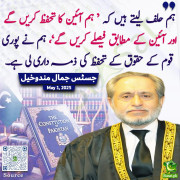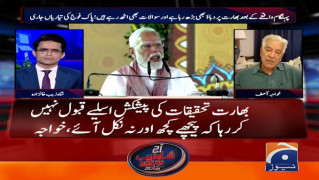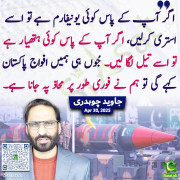WatanDost
Chief Minister (5k+ posts)
Launching the Missile That Made History
Three former mujahedeen recall the day when they started to beat the SovietsOCTOBER 1, 2011
By MICHAEL M. PHILLIPS
[HI]Outside Jalalabad, Afghanistan, 25 years ago this week, an angry young man named Abdul Wahab Quanat recited his prayers, walked onto a farm field near a Soviet airfield, raised a Stinger missile launcher to his shoulder and shot his way into history.
[/HI]It was the first time since the Soviet invasion seven years earlier that a mujahedeen fighter had destroyed the most feared weapon in the Soviet arsenal, a Hind attack helicopter. The event panicked the Soviet ranks, changed the course of the war and helped to break up the USSR itself.

Getty Images A mujahedeen fighter fighter aims a Stinger missile at a passing airplane in 1988.
Today, Mr. Wahab is general manager of the Afghan central-bank branch near the Khyber Pass, a middle-age man who carries tinted bifocals in his vest pocket and chooses Diet Pepsi over regular. Mr. Wahab and the two other Stinger gunners at the airfield that dayZalmai and Abdul Ghaffarhave now joined the post-jihad establishment. Mr. Zalmai is sub-governor of Shinwar District, and Mr. Ghaffar is a member of parliament.
They nurse a gauzy nostalgia for the joys of being young jihadists. "Those were good, exciting times," Mr. Wahab says. "Now I'm a banker. It's boring."
The Soviet invasion touched off three decades of violent swings in Afghanistan, from socialism to warlordism to Islamic fundamentalism to today's flawed democracy. Amid this tortured history, the U.S. makes occasional appearancesincluding its mid-1980s decision to supply the mujahedeen with Stingersthe consequences of which often weren't apparent until much later.
[HI]At the time, the Soviets and their Afghan allies were on the offensive, thanks to the Hinds. Heavily armored, the helicopters were indifferent to ground fire as they strafed and rocketed mujahedeen and civilians alike. In 1986, the Reagan administration and its congressional allies put aside qualms about dispatching missile launchers. The move likely contributed to the Soviet withdrawal.[/HI] Soviet leader Mikhail Gorbachev, faced with an imploding domestic economy, was already seeking an exit from a costly war.
There's no straight line from the U.S. move to arm the mujahedeen to 9/11 and the 2001 American invasion, but the decision has echoed through the subsequent decades of turmoil. After Kabul's fall, and with American attention elsewhere, the mujahedeen fell on each other. Messrs. Ghaffar and Zalmai squabbled over money and weapons.

Michael M. Phillips for The Wall Street Journal AAbdul Wahab Quanat shows how he fired the first Stinger missile at a Soviet Hind helicopter 25 years ago.
"I disarmed his men, and he disarmed my men," says Mr. Zalmai. (They have since reconciled, and Mr. Ghaffar's daughter married Mr. Zalmai's nephew.)
[HI]The Taliban emerged on top, and the U.S. Central Intelligence Agency spent years trying to recover 600 unused Stingers, including 53 that found their way to Mullah Omar, the Taliban leader who hosted Osama bin Laden during the 9/11 attacks, according to the book "Ghost Wars" by Steve Coll.
[/HI]
[HI]Key figures from that era, including those who received U.S. support, have ended up on the other side. Gulbuddin Hekmatyar, the ruthless head of the fundamentalist Hezb-e-Islami mujahedeen, provided the Stinger gunmen.[/HI] Among Mr. Hekmatyar's other backers was bin Laden, who paid Arab militants to fight in the Afghan jihad and in doing so earned the trust of the Taliban.
[HI]As Mr. Wahab remembers, the Pakistani officials who were acting as a conduit between the U.S. and the Afghan fighters packed him and nine other Hekmatyar fighters into the back of a truck, covered it in a tarp so they wouldn't see where they were going, and took them to a training camp in Rawalpindi, Pakistan.
[/HI]
[HI]For a month, they practiced with dummy Stingers aimed at a hanging light. Pakistani officers then handed over real missiles to the eight successful graduates. [/HI]One team headed to Kabul to shoot down troop-transport planes. The other, headed by Mr. Ghaffar, an engineer by training, was dispatched to go after the Hind helicopters.
As they parted, one Pakistani instructor tearfully called Mr. Wahab a "holy warrior" and reminded him to hit the switch that arms the missile's heat-seeking device. After a two-day walk, the fighters spent the night of Sept. 25 in an abandoned village on the outskirts of Jalalabad. [HI]The next afternoon, Mr. Ghaffar and his men knelt down for prayers and then made their way into a farm field, where they spotted about 10 helicopters returning to the airfield.[/HI][HI]
The best student at Stinger camp, Mr. Wahab took the first shot. The missile made a whirring noise that changed tone as it locked onto a Hind. Mr. Wahab recited a prayer. "In the name of Allah, the supreme and almighty, God is great." He recalls the Hind's tail rotor breaking off, while the front section burst into flames and plummeted to earth, cockpit first.
[/HI][HI]
"I'll never forget that moment," he says now. "Those helicopters had killed so many people, left so many orphans."
[/HI]Messrs. Ghaffar and Zalmai fired next. Mr. Wahab says neither missile hit a Hind; Mr. Ghaffar's, he says, hit the ground, while Mr. Zalmai forgot the heat-seeker-arming switch.
Mr. Ghaffar remembers one missile hitting a helicopter, but says it could have been either one. Mr. Zalmai says he can't recall for certain but admits he's not a great marksman. (The CIA reported that three helicopters had gone down.)
What is certain is that Mr. Ghaffar then shouldered a spare Stinger and this time sent a Hind crashing to earth. Mr. Wahab recalls mujahedeen cheering when the helicopters went down. Terrified that the Soviets would send tanks after them, the three scampered back to Pakistan.
[HI]Mr. Ghaffar dined out on his success for months, meeting with the CIA and having tea in Peshawar with Rep. Charlie Wilson, the late Texas Democrat and relentless champion of the mujahedeen.
[/HI]
[HI]The Ghaffar team had proved the Stingers so effective that the CIA sent some 2,300 more. Soon the mujahedeen were shooting down helicopters, transport planes and jets in large numbers. "If we hadn't used them correctly, they probably wouldn't have provided any more Stingers for the Afghan jihad," says Mr. Ghaffar. One Soviet squadron lost 13 of 40 planes in the year that followed, 10 to Stingers. The final Soviet troops retreated from Afghanistan in 1989, and the mujahedeen took Kabul in 1992.
[/HI]
"We wrote historyI miss those days," says Mr. Ghaffar, now 54. A member of parliament, he denies accusations by some locals that he has become a land-grabbing power broker.
Mr. Zalmai, who estimates his age at 50, barely had a beard when he took to the mountains in 1980. He smiles when he remembers blowing the tracks off of Soviet tanks. "I was good at it," he says. He admits that his memories are filtered through the haze of age and two brain-jarring attempts on his life during the current insurgency.
As a local administrator, Mr. Zalmai spends a good deal of time these days complaining that the Americans failed to consult him about plans to raze one government office to build another.
"When you're young, you're emotional about everything," Mr. Zalmai says of his days as a jihadist. "When you're old, everything can be solved by talking."
After the Taliban takeover, Mr. Wahab fled to Pakistan, where he ran a fabric shop. After the Taliban fell, he returned to Afghanistan and landed the central-bank job. Now 49, he supervises commercial banks adjacent to the Khyber Pass, through which mujahedeen weapons and fighters once flowed.
[HI]"When I was a mujahedeen on a mountaintop, I'd see the lights of Jalalabad and wish I were there," Mr. Wahab says. "Now when I'm in Jalalabad, I miss being in a stone hideout in the mountains with the mujahedeen."
Mr. Wahab has little patience for today's insurgents. "We had an enemythe Russians," he says. "These suicide bombers today attack Americans and Muslims. What's the point?"
[/HI]Write to Michael M. Phillips at [email protected]
Three former mujahedeen recall the day when they started to beat the SovietsOCTOBER 1, 2011
By MICHAEL M. PHILLIPS
[HI]Outside Jalalabad, Afghanistan, 25 years ago this week, an angry young man named Abdul Wahab Quanat recited his prayers, walked onto a farm field near a Soviet airfield, raised a Stinger missile launcher to his shoulder and shot his way into history.
[/HI]It was the first time since the Soviet invasion seven years earlier that a mujahedeen fighter had destroyed the most feared weapon in the Soviet arsenal, a Hind attack helicopter. The event panicked the Soviet ranks, changed the course of the war and helped to break up the USSR itself.

Getty Images A mujahedeen fighter fighter aims a Stinger missile at a passing airplane in 1988.
Today, Mr. Wahab is general manager of the Afghan central-bank branch near the Khyber Pass, a middle-age man who carries tinted bifocals in his vest pocket and chooses Diet Pepsi over regular. Mr. Wahab and the two other Stinger gunners at the airfield that dayZalmai and Abdul Ghaffarhave now joined the post-jihad establishment. Mr. Zalmai is sub-governor of Shinwar District, and Mr. Ghaffar is a member of parliament.
They nurse a gauzy nostalgia for the joys of being young jihadists. "Those were good, exciting times," Mr. Wahab says. "Now I'm a banker. It's boring."
The Soviet invasion touched off three decades of violent swings in Afghanistan, from socialism to warlordism to Islamic fundamentalism to today's flawed democracy. Amid this tortured history, the U.S. makes occasional appearancesincluding its mid-1980s decision to supply the mujahedeen with Stingersthe consequences of which often weren't apparent until much later.
[HI]At the time, the Soviets and their Afghan allies were on the offensive, thanks to the Hinds. Heavily armored, the helicopters were indifferent to ground fire as they strafed and rocketed mujahedeen and civilians alike. In 1986, the Reagan administration and its congressional allies put aside qualms about dispatching missile launchers. The move likely contributed to the Soviet withdrawal.[/HI] Soviet leader Mikhail Gorbachev, faced with an imploding domestic economy, was already seeking an exit from a costly war.
There's no straight line from the U.S. move to arm the mujahedeen to 9/11 and the 2001 American invasion, but the decision has echoed through the subsequent decades of turmoil. After Kabul's fall, and with American attention elsewhere, the mujahedeen fell on each other. Messrs. Ghaffar and Zalmai squabbled over money and weapons.

Michael M. Phillips for The Wall Street Journal AAbdul Wahab Quanat shows how he fired the first Stinger missile at a Soviet Hind helicopter 25 years ago.
"I disarmed his men, and he disarmed my men," says Mr. Zalmai. (They have since reconciled, and Mr. Ghaffar's daughter married Mr. Zalmai's nephew.)
[HI]The Taliban emerged on top, and the U.S. Central Intelligence Agency spent years trying to recover 600 unused Stingers, including 53 that found their way to Mullah Omar, the Taliban leader who hosted Osama bin Laden during the 9/11 attacks, according to the book "Ghost Wars" by Steve Coll.
[/HI]
[HI]Key figures from that era, including those who received U.S. support, have ended up on the other side. Gulbuddin Hekmatyar, the ruthless head of the fundamentalist Hezb-e-Islami mujahedeen, provided the Stinger gunmen.[/HI] Among Mr. Hekmatyar's other backers was bin Laden, who paid Arab militants to fight in the Afghan jihad and in doing so earned the trust of the Taliban.
[HI]As Mr. Wahab remembers, the Pakistani officials who were acting as a conduit between the U.S. and the Afghan fighters packed him and nine other Hekmatyar fighters into the back of a truck, covered it in a tarp so they wouldn't see where they were going, and took them to a training camp in Rawalpindi, Pakistan.
[/HI]
[HI]For a month, they practiced with dummy Stingers aimed at a hanging light. Pakistani officers then handed over real missiles to the eight successful graduates. [/HI]One team headed to Kabul to shoot down troop-transport planes. The other, headed by Mr. Ghaffar, an engineer by training, was dispatched to go after the Hind helicopters.
As they parted, one Pakistani instructor tearfully called Mr. Wahab a "holy warrior" and reminded him to hit the switch that arms the missile's heat-seeking device. After a two-day walk, the fighters spent the night of Sept. 25 in an abandoned village on the outskirts of Jalalabad. [HI]The next afternoon, Mr. Ghaffar and his men knelt down for prayers and then made their way into a farm field, where they spotted about 10 helicopters returning to the airfield.[/HI][HI]
The best student at Stinger camp, Mr. Wahab took the first shot. The missile made a whirring noise that changed tone as it locked onto a Hind. Mr. Wahab recited a prayer. "In the name of Allah, the supreme and almighty, God is great." He recalls the Hind's tail rotor breaking off, while the front section burst into flames and plummeted to earth, cockpit first.
[/HI][HI]
"I'll never forget that moment," he says now. "Those helicopters had killed so many people, left so many orphans."
[/HI]Messrs. Ghaffar and Zalmai fired next. Mr. Wahab says neither missile hit a Hind; Mr. Ghaffar's, he says, hit the ground, while Mr. Zalmai forgot the heat-seeker-arming switch.
Mr. Ghaffar remembers one missile hitting a helicopter, but says it could have been either one. Mr. Zalmai says he can't recall for certain but admits he's not a great marksman. (The CIA reported that three helicopters had gone down.)
What is certain is that Mr. Ghaffar then shouldered a spare Stinger and this time sent a Hind crashing to earth. Mr. Wahab recalls mujahedeen cheering when the helicopters went down. Terrified that the Soviets would send tanks after them, the three scampered back to Pakistan.
[HI]Mr. Ghaffar dined out on his success for months, meeting with the CIA and having tea in Peshawar with Rep. Charlie Wilson, the late Texas Democrat and relentless champion of the mujahedeen.
[/HI]
[HI]The Ghaffar team had proved the Stingers so effective that the CIA sent some 2,300 more. Soon the mujahedeen were shooting down helicopters, transport planes and jets in large numbers. "If we hadn't used them correctly, they probably wouldn't have provided any more Stingers for the Afghan jihad," says Mr. Ghaffar. One Soviet squadron lost 13 of 40 planes in the year that followed, 10 to Stingers. The final Soviet troops retreated from Afghanistan in 1989, and the mujahedeen took Kabul in 1992.
[/HI]
"We wrote historyI miss those days," says Mr. Ghaffar, now 54. A member of parliament, he denies accusations by some locals that he has become a land-grabbing power broker.
Mr. Zalmai, who estimates his age at 50, barely had a beard when he took to the mountains in 1980. He smiles when he remembers blowing the tracks off of Soviet tanks. "I was good at it," he says. He admits that his memories are filtered through the haze of age and two brain-jarring attempts on his life during the current insurgency.
As a local administrator, Mr. Zalmai spends a good deal of time these days complaining that the Americans failed to consult him about plans to raze one government office to build another.
"When you're young, you're emotional about everything," Mr. Zalmai says of his days as a jihadist. "When you're old, everything can be solved by talking."
After the Taliban takeover, Mr. Wahab fled to Pakistan, where he ran a fabric shop. After the Taliban fell, he returned to Afghanistan and landed the central-bank job. Now 49, he supervises commercial banks adjacent to the Khyber Pass, through which mujahedeen weapons and fighters once flowed.
[HI]"When I was a mujahedeen on a mountaintop, I'd see the lights of Jalalabad and wish I were there," Mr. Wahab says. "Now when I'm in Jalalabad, I miss being in a stone hideout in the mountains with the mujahedeen."
Mr. Wahab has little patience for today's insurgents. "We had an enemythe Russians," he says. "These suicide bombers today attack Americans and Muslims. What's the point?"
[/HI]Write to Michael M. Phillips at [email protected]






























